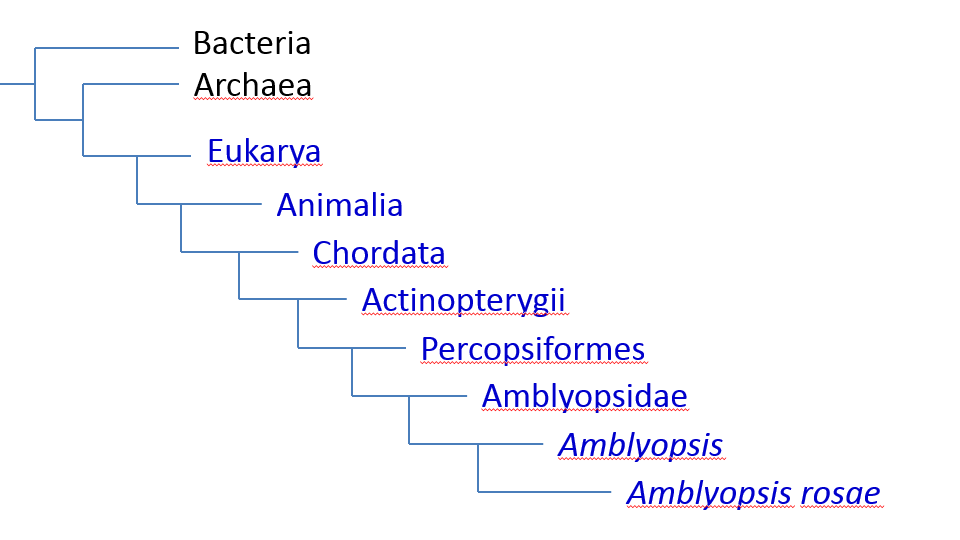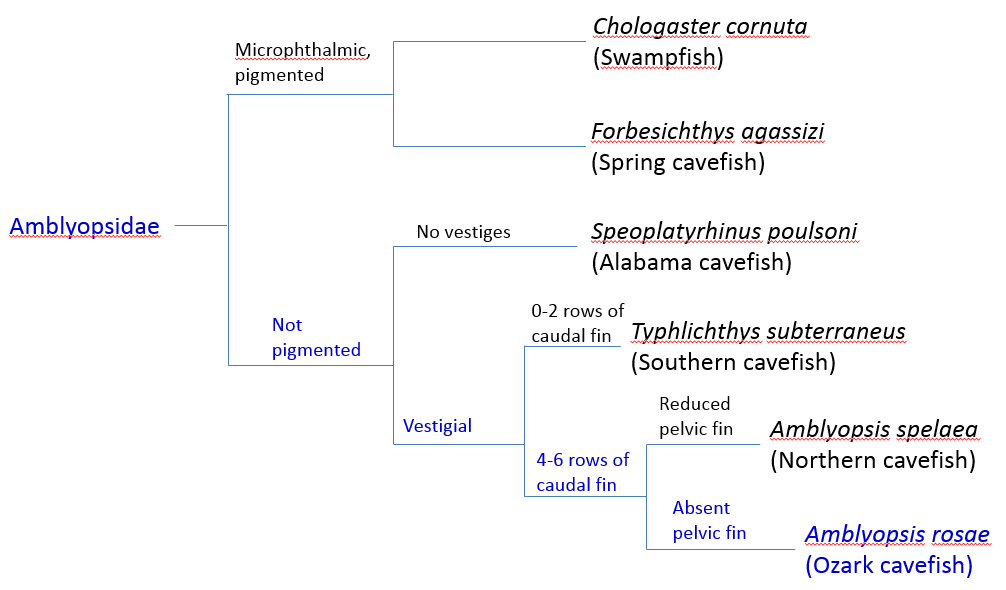Classifying the Ghost
Welcome to the classification page! This page is going to take you on a ride through the evolutionary origins of the Ozark cavefish.
Figure. 1 Phylogenetic tree based on each taxonomic level (blue text color) for Amblyopsis rosae.
Domain: Eukarya
-The Ozark cavefish falls within this category because it has membrane bound organelles, as well as a true nucleus. The cell structure within the Eukarya domain is much more complex than cells within the Archaea or Bacteria (Campbell et al. 2007).
Kingdom: Animalia
-The Ozark cavefish falls within this category because it is multicellular, meaning they have multiple cells within the body. The cells within the body are specialized for particular functions. The Ozark cavefish is heterotrophic, meaning that they receive their nourishment from other organisms. The Ozark cavefish also falls within this section because it ingests its food and then digests the food within an internal cavity in the body. The organisms that fall within this category also have some type of skeletal support structure/tissue organization (Campbell et al. 2007).
Phylum: Chordata
-The Ozark cavefish falls within this category because it has a central nervous system consisting of the brain and notochord. They also have pharyngeal slits (pharynx means “throat”) on the sides of their heads that eventually turn into the gills in an adult fish, which allows for breathing. These organisms also exhibit some form of segmentation. The members of this phylum also have a postanal tail. In this case, the tail of the Ozark cavefish is curved (Campbell et al. 2007).
Class: Actinopterygii
-This category is mainly classified as the ray-finned fishes. In contrast to cartilaginous fish, the Ozark cavefish fits in this category for having a rigid endoskeleton made of bone. The main characteristic that differentiates these fish from other classes of fish is that they have a swim bladder. Meaning, the Ozark cavefish can hover and maintain buoyancy without moving. These fish also have a gill cover that transports water through the gills, which helps the Ozark cavefish breathe while remaining motionless. The most obvious characteristic of these fish is that they have ray-finned tails (Froese, 2014).
Order: Percopsiformes
-The groups of fish that fall within this category have a distinct arrangement of the positions of their fins. There is a small fin located between the dorsal and the tail fin. There are also two anal fins that are located on the underbelly of the fish. In the Ozark cavefish, the two anal fins are located much farther back than the pelvic fins of other fish (Froese, 2014).
Family: Amblyopsidae
-The main characteristic of the Amblyopsidae family is that they are blind or lack any type of eye structure. The Ozark cavefish lives most of its life in darkness and has developed specialized structures for this situation, such as sensory organs to detect stimuli in the environment. The Ozark cavefish, like other fish in this family, lack pigmentation, which is also a result of constant darkness (Missouri Department of Conservation, (MDC), 2014).
Figure 2. Phylogenetic tree of different species
within the Amblyopsidae family. (Characteristics of Amblyopsis rosae
are written in blue).
The closest relative of the Ozark cavefish is its sister taxa, the Northern
cavefish.
Genus: Ambylopsis
-To understand the characteristics that separate the Amblyopsis genus from other genus’s, refer to the section “Family: Amblyopsidae” listed above.
Species: Amblyopsis rosae
-One aspect that differentiates the Amblyopsis rosae from other species is that the Ozark cavefish lacks pelvic fins which are present in other species of cavefish. The root, “amblys”, of the Greek word Amblyopsis means darkness. The ending of the word, “ops”, translates to mean shape (Froese, 2014).
Next, check out the habitat page to learn more about the types of environments the Ozark cavefish can sustain.

